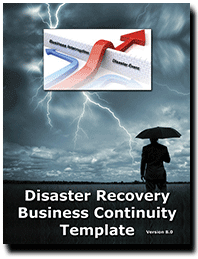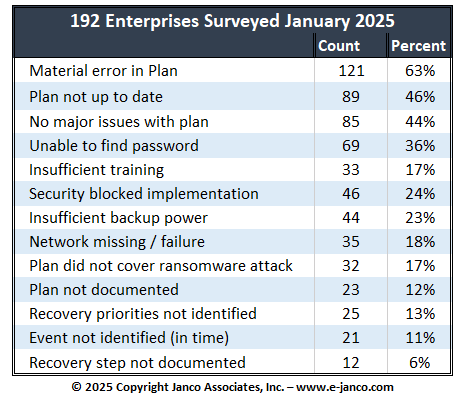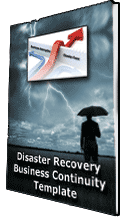Disaster Recovery Business Continuity Plan Issues
Why is the Disaster Recovery Business Continuity Plan Out of Date?
Order DRP BCP Template DRP BCP Sample
Over 33% of all Disaster Recover Business Continuity Plans are not current according to data gathered by Janco
 There are plenty of partial, outdated, or ineffective disaster and business continuity plans out there - why is it so difficult to get it right?
There are plenty of partial, outdated, or ineffective disaster and business continuity plans out there - why is it so difficult to get it right?
- Data collection - How do you collect the data for the disaster and business continuity plan in the first place? There is no one single source for everything you need, particularly if you are trying to integrate relevant external information such as support dates, power consumption, etc. Every vendor delivers this information in different formats, different frequencies, and different vehicles - ranging from data sheets to websites to release notes.
- Data inconsistency - How do you handle the inherent inconsistencies in data? For example, OS version numbers are often conflicting; vendors change their product names or renumber versions over time, etc. Normalizing the data (making it adhere to consistent rules and categories) is a cumbersome task and the accuracy and consistency of the data needs to be reassessed at every step.
- Categorization - If you want to categorize the information in the disaster and business continuity plan, you have to create the taxonomy (or hierarchical categorization) for the industry data. This alone is a significant task, there are many ways to slice and dice the universe of technology products, and no standards have been defined within the IT industry to define this information in a consistent manner.
- Manageability - Any extensive technology disaster and business continuity plan is a large and complex data store. A spreadsheet is insufficient for storing and managing rich structured data for thousands of products and vendors. The disaster and business continuity plan should be able to track and maintain the complex relationships between technologies and categories (parent/child relationships, one-to-many mappings, and so on). Developing an appropriate, extensible data store is a complex undertaking.
- Maintenance - As soon as you have finished the disaster and business continuity plan, you have to start updating it. The Information Technology industry is constantly changing, which means that your work is never done. If you go through a massive effort to produce a disaster and business continuity plan for a single business function, the value of that investment is lost if you cannot keep it up to date.
Order DRP BCP Template DRP BCP Sample
Survey of Disaster Recovery/Business Continuity Plans that were activated
In a review of almost 300 DR/BC plans that were activated it was found that only 31% of all of them had no major issue. While 44% had material errors
Note - does not equal 100% as duplicate factors selectedThe Disaster Recovery Business Continuity Solution
The Disaster Recovery Plan (DRP) can be used as a Disaster Planning template for any size of enterprise. The Disaster Recovery template and supporting material have been updated to be ISO, Sarbanes-Oxley and HIPAA compliant. The Disaster Planning Template comes as both a Word document and a static fully indexed PDF document and includes:
- Disaster Recovery Plan and Business Continuity Template
- Business and IT Impact Analysis Questionnaire
- Work Plan
- Disaster Recovery / Business Continuity Audit Program
Preparation for Disaster Recovery / Business Continuity in light of SOX has two primary parts. The first is putting systems in place to completely protect all financial and other data required to meet the reporting regulations and to archive the data to meet future requests for clarification of those reports. The second is to clearly and expressly document all these procedures so that in the event of a SOX audit, the auditors clearly see that the DRP exists and will appropriately protect the data.
Order DRP BCP Template DRP BCP Sample
The DRP template is over 200 pages and includes everything needed to customize the Disaster Recovery Plan to fit your specific requirement. The electronic document includes proven written text and examples for the following major sections of a disaster recovery plan:
- Plan Introduction
- Business Impact Analysis - including a sample impact matrix
- DRP Organization Responsibilities pre and post disaster - DRP checklist
- Backup Strategy for Data Centers, Departmental File Servers, Wireless Network servers, Data at Outsourced Sites, Desktops (In office and "at home"), Laptops and PDA's
- Recovery Strategy including approach, escalation plan process and decision points
- Disaster Recovery Procedures in a check list format
- Plan Administration Process
- Technical Appendix including definition of necessary phone numbers and contact points
- Job Description for Disaster Recovery Manager (3 pages long) - entire disaster recovery team job descriptions are available
- Work Plan to modify and implement the template. Included is a list of deliverables for each task. (Risk Assessment and Vulnerability Assessment)
There is a extensive section that show how a full test of the DRP can be conducted. It includes
- Disaster Recovery Manager Responsibilities
- Distribution of the Disaster Recovery Plan
- Maintenance of the Business Impact Analysis
- Training of the Disaster Recovery Team
- Testing of the Disaster Recovery Plan
- Evaluation of the Disaster Recovery Plan Tests
- Maintenance of the Disaster Recovery Plan
Click on the link below to get the DRP/BC sample pages now and make it part of your disaster recovery toolkit.
Order DRP BCP Template DRP BCP Sample
Backup Matrix - Sample TemplateOrder DRP BCP Template DRP BCP Sample




